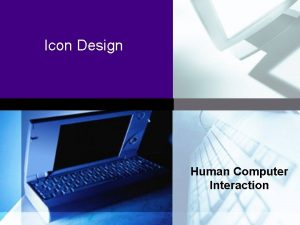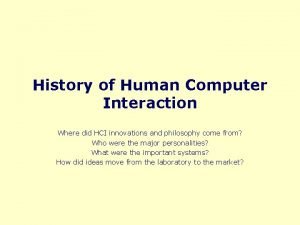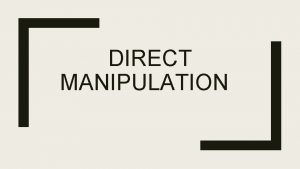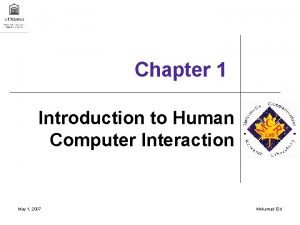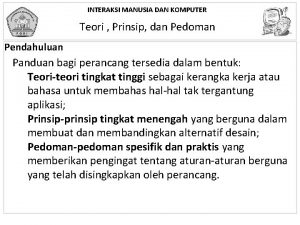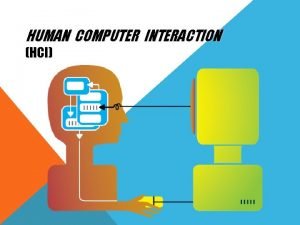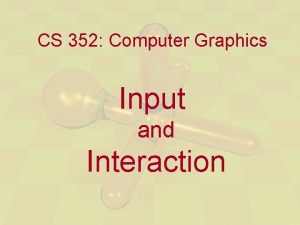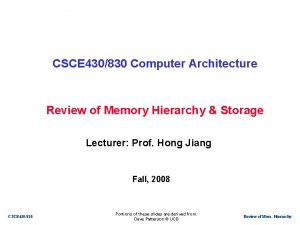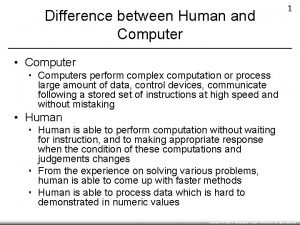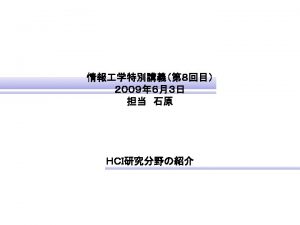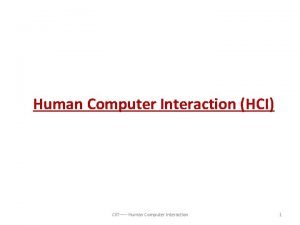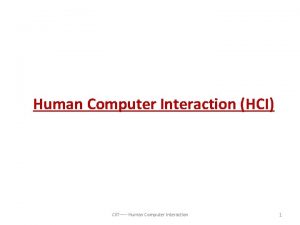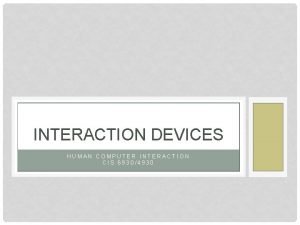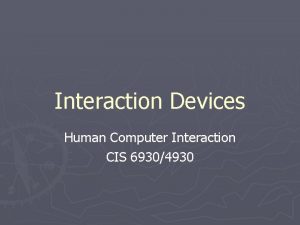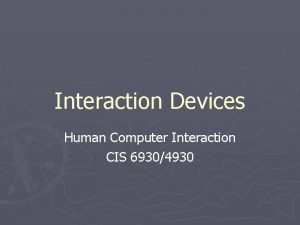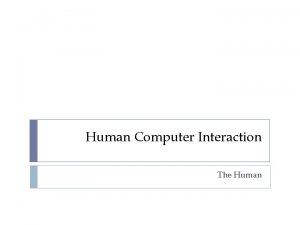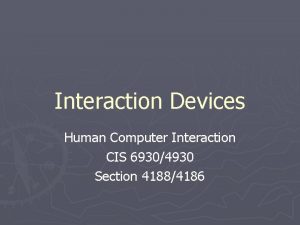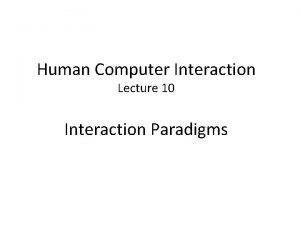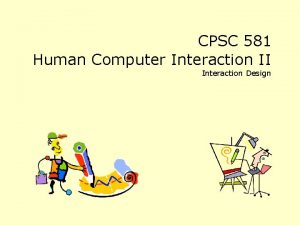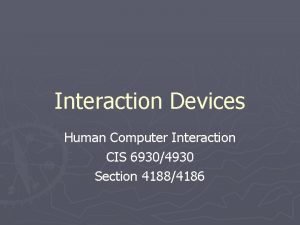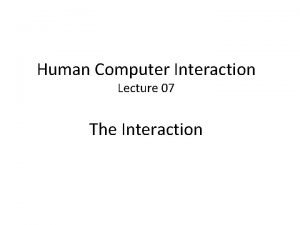Principle of Human Computer Interaction Faculty of Computing



























































- Slides: 59

Principle of Human Computer Interaction Faculty of Computing and Information Technology King Abdul Aziz University Khalid Al-Omar 1

Introduction to HCI Lecture 2 2

Outline • Introduction • What is HCI? – The HCI Challenge – HCI is Not about – HCI is about • The goals of HCI • What is Usability? • Why is usability important? – Why HCI is Important in the Context of WWW? – It is not Simple to Make Good User Interfaces • Examples of good and bad design 3

Introduction • Interacting with technology has become an essential part of everyday life for the majority of people. • The average user of a computer system is now less likely to understand the technology. Since, there are different types of technology they have to use. • People are busy and may spend little or no time actually learning a new system. 4

Introduction. . (cont. ) • Therefore, computer systems should be easy to use, easy to learn, and with no errors. • To design and develop of such a system is a major concern of HCI 5

What is HCI? • Human-computer interaction (HCI): “is a discipline concerned with the design, evaluation and implementation of interactive systems for human use and with study of major phenomena surrounding them. ” (ACM SIGCHI, 1992, p. 6)

What is HCI? • HCI (human-computer interaction) is the study of interaction between people (users) and computers. • Interaction between users and computers occurs at the user interface • The golden principle in HCI is that “people should come first”. 7

What. . (cont. ) HCI consists of three parts: • Human: could be an individual user or a group of users. • Computer: could be any technology ranging from the general desktop computer to a large scale computer system. • Interaction: any direct or indirect communication between a human and computer. 8

What. . (cont. ) • HCI concentrates on the study of human factors • The study of human factors started during the Second World War by US army. • Usability was born because of badly designed arms that caused “friendly fire” during war. 9

The HCI Challenge 10

HCI is Not about • Making the interface look pretty • Only about desktop computers (and that goes for computing as well!) • Something that would be nice to do but usually there’s no time for it 11

HCI is about • • • Understanding the users Understanding users tasks Understanding the surrounding environment GUI requirements gathering and analysis Design prototype Evaluate the system 12

The goals of HCI • The goal of HCI “is to develop or improve the safety, utility, effectiveness, efficiency and usability of system that include computers. ” (Interacting with computers, 1989, p 3) 13

The goals of HCI • The goals of HCI are to produce usable and safe systems, as well as functional systems. In order to fulfill that, developers must attempt to: – – Understand how people use technology Building suitable systems Achieve efficient, effective, and safe interaction Put people first People needs, capabilities and preferences should come first. People should not have to change the way that they use a system. Instead, the system should be designed to match their requirements 14

What is Usability? • A usable system is: – – – – easy to use easy to learn easy to remember how to use effective to use efficient to use safe to use enjoyable to use 15

Why is usability important? A Good user-interface can: 1. Earn a company billions. 2. Increase users loyalty. 3. Increase users trust. 4. Makes users happy : ) 16

Why. . (cont. ) A Bad user-interface can: 1. be annoying, embarrassing, frustrating, and even deadly. 2. Increase mistakes in data entry and system operation. 3. Makes functions become completely inaccessible. 4. System failure because of user rejection. 17

Why HCI is Important in the Context of WWW? • Competition is very close (just another link…) • Comparison is easily possible (example – Online. Shop) • Users who can’t find the product in the shop can not buy it • Users who are not able to fill in correctly the order form are not going to buy 18

It is not Simple to Make Good User Interfaces Basic misconceptions: • If I (the developer) can use it, everyone can use it • If our non-technical staff can use it, everyone can • Good user interfaces are applied common sense • A system is usable if all style guidelines are met 19

Examples of good and bad design 20

Examples. . (cont. ) 21

Examples. . (cont. ) 22

Examples. . (cont. ) 23

Examples. . (cont. ) 24

Examples. . (cont. ) 25

Introduction to HCI Lecture 3 26

Outline • Disciplines Contributing to Human-Computer Interaction • Is HCI really Important? – A real life example – The importance of HCI – Reasons for Failures • Traditional approach • User-centred design • Examples of good and bad design 27

Disciplines Contributing to Human. Computer Interaction 28

Is HCI really Important? 29

A real life example Example about: Health and safety concerns If the video doesn’t record a TV program because we pressed the wrong button, we are likely to feel angry. A real example: a pilot shuts down the wrong engine and the plane crashes (as happened near Leicestershire, in England on the M 1 motorway in 1989), this is obviously more serious. 47 died 30

A real. . (cont. ) Example about: direct correlation between HCI and sales • NYNEX: a telecommunicationon company in Italy – Purpose: to increase the performance of helpdesk office – Decided to improve the usability of the helpdesk operator interface – Reduced the process time 1 second per call Result: $ 3, 000 benefit / year www. metu. edu. tr/~acengiz/biltek_sunu m 31

The importance of HCI 1. Can Preventing accidents 2. Health and safety concerns 3. Can reduce the cost of customer training and support 4. Direct correlation between HCI and sales 5. HCI can provide you a job. 32

Time to Think! • What is the percentage of software development projects that fails? • A. 20% • B. 35% • C. 55% • D. 85% 33

• Fact - Fletcher Buckley “: 85% of Software projects are either late or delivered without satisfying the specification. ” But WHY? 34

Reasons for Failures Projects in general fail for various reasons: • lack of senior management commitment • lack of user involvement • lack of user requirements specifications • poor project planning and team problems 35

Traditional approaches to system development • Is concerned with producing software, software specification, maintainability, and testing • Generally considers the interface to be just another software component. 36

Example of traditional approach Requirements specification Analysis Design Implementation The waterfall model Testing Operation and maintenance 37

Introduction to User Centered approach This approach normally involves a number of key activities throughout the development of the software including: • Involving users • Obtaining their feedback on the design • Providing prototypes for system evaluation and redesign in light of user feedback and comments. 38

User Centered approach • Real users involved at each step of the process • Find out about the users before requirement specification • Design and implementation • Review (usability test) with the users 39

The life cycle for interactive systems user needs cannot assume a linear sequence of activities as in the waterfall model lots of feedback! 40

User Centered Development 1. 2. 3. 4. 5. Data Collection Data Analysis Prototyping Design Evaluation 41

1. Data Collection • Data recording – Using media • Interviews – Stakeholder interviews – Subject Matter Expert interviews – User and customer interviews • Questionnaires – Surveys, product reviews • Literature review – Studying existing systems 42

2. Data Analysis • Requirement analysis – Formal specifications of the system • User analysis – Identifying and understanding the user • Task analysis – Steps user take to accomplish this task • Functional analysis – Functions that system perform to help the users carry out their task 43

3. Prototyping Advantages of Prototyping: • Users are actively involved in the development • It provides a better system to users • The users get a better understanding of the system being developed. • Errors can be detected much earlier • Quicker user feedback is available leading to better solutions 44

4. Design • Goals – Achieving goals • Users and systems – Understanding the raw materials: computer and human • Limitations – Accepting limitations of humans and of design 45

5. Evaluation • Testing the usability, functionality and acceptability of an interactive system • Expert evaluation – Evaluation by Subject Matter Experts • User evaluation – Evaluation by user or customer 46

Designer vs. Users Making a photocopy • Why this photocopier does not work? What do you think! 47

Designer vs. Users Designer meant by ‘C’ = Clear People thought that ‘C’ = Copy 48

Examples. . (cont. ) 49

Examples. . (cont. ) 50

Examples. . (cont. ) 51

Examples. . (cont. ) 52

Examples. . (cont. ) 53

Examples. . (cont. ) 54

Examples. . (cont. ) 55

Examples. . (cont. ) 56

Examples. . (cont. ) 57

Examples. . (cont. ) 58

References • • http: //www. cs. bham. ac. uk/~rxb/Teaching/HCI%20 II/intro. html http: //www. baddesigns. com/examples. html http: //www. goodexperience. com/tib/archives/webtech/ http: //pages. cpsc. ucalgary. ca/~saul/hci_topics/psych. html http: //homepage. mac. com/bradster/iarchitect/ www. useit. com http: //faculty. ed. umuc. edu/~meinkej/inss 690/wilson. htm 59
 Stanford human computer interaction
Stanford human computer interaction What is the symbol of hci
What is the symbol of hci Paradigms in hci
Paradigms in hci Visual channel in hci
Visual channel in hci History of human computer interaction
History of human computer interaction Direct manipulation hci
Direct manipulation hci Hci chapter 1
Hci chapter 1 The future of human computer interaction
The future of human computer interaction Yang termasuk model antarmuka objek-aksi
Yang termasuk model antarmuka objek-aksi Human computer interaction syllabus
Human computer interaction syllabus Model konseptual
Model konseptual Alan dix hci
Alan dix hci Human computer interaction diagram
Human computer interaction diagram Ergonomics in human computer interaction
Ergonomics in human computer interaction Hci merupakan
Hci merupakan University of bridgeport computer science
University of bridgeport computer science Bridgeport engineering department
Bridgeport engineering department Fsu computer science
Fsu computer science Ucl computers
Ucl computers Brown university computer science
Brown university computer science Conventional computing and intelligent computing
Conventional computing and intelligent computing Hydrophobic interaction chromatography slideshare
Hydrophobic interaction chromatography slideshare Hei ap human geography
Hei ap human geography Ap
Ap Human characteristics of portland oregon
Human characteristics of portland oregon Spatial interaction ap human geography
Spatial interaction ap human geography Nile river map
Nile river map What is human geography
What is human geography Geography diffusion
Geography diffusion Ap human geography chapter 5 frq
Ap human geography chapter 5 frq Perceptual region definition
Perceptual region definition Human environment interaction
Human environment interaction Human environment interaction
Human environment interaction Expansion diffusion def
Expansion diffusion def Rome human environment interaction
Rome human environment interaction Interaction in computer graphics
Interaction in computer graphics Design principles of computer clusters
Design principles of computer clusters Zonbu computer green computing
Zonbu computer green computing Phoenician alphabet is what computing periods?
Phoenician alphabet is what computing periods? Territoriality
Territoriality Cumulative causation definition ap human geography
Cumulative causation definition ap human geography What is optimality principle in computer networks
What is optimality principle in computer networks What is optimality principle in computer networks
What is optimality principle in computer networks Subnet
Subnet Locality principle in computer architecture
Locality principle in computer architecture The optimality principle in computer networks
The optimality principle in computer networks Confinement principle in computer system security
Confinement principle in computer system security Digital computer works on the principle of
Digital computer works on the principle of Human vs non human bones
Human vs non human bones Human needs and human development
Human needs and human development Chapter 8 human needs and human development
Chapter 8 human needs and human development Gni definition ap human geography
Gni definition ap human geography Human nouns
Human nouns Differences between human and computer
Differences between human and computer Cs766
Cs766 University of split faculty of maritime studies
University of split faculty of maritime studies Alamo colleges faculty salary schedule
Alamo colleges faculty salary schedule Hahnville high school faculty
Hahnville high school faculty Importance of faculty in higher education
Importance of faculty in higher education Hubert kairuki memorial university faculty of medicine
Hubert kairuki memorial university faculty of medicine

